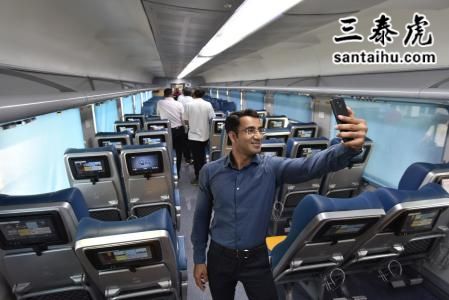Why didn't India opt for 600 kph Maglev technology and rather opted for 300 kph wheel based HSR technology for India's bullet train program?
为什么印度的高铁项目没有选择时速600公里的磁悬浮技术,而是选择时速300公里的基于轮毂的高铁技术?


quora评论翻译:
Raghunandan Reddy C, studied Civil Engineering at Texas A&M University - Kingsville (2017)
Answered Feb 6To explain briefly, more expensive and an unproven technology
简单说,更贵,技术还有待验证
Piyush Mahajan
Beggers can not the choosers
要饭的哪能挑肥拣瘦,没有选择权就只好满足于能得到的东西
Rohit Kapoor, lives in India
Answered Jul 2, 2017Investment issues… too high for being viable that too when logistics and maintenance back up for a 600 Kmph train may not be available in India!
投资问题。成本太高。印度基础设施支撑不起600公里时速的火车。
Sashank Reddy, works at Neato Robotics
Updated May 4, 2018
萨尚克.雷迪,受雇于美国俐拓
1. The cost : Maglevs need completely new land, new all elevated route for the train and new stations. You are looking at 4+ times the cost. Spending that much is nonsense when the public cant afford $1 ticket every day. All foreign technology costs in $$ ; about 10 times what it would cost us.
2. Maglevs need superconducting materials to a certain degree. They are expensive and need to be fully imported.
3. There is only one maglev commercially running in Shanghai . It has been making headlines for not being so profitable to operate.
1、成本:磁悬浮需要全新的地面、高架线路和车站,成本要高4倍。当印度民众都负担不起每天1美元的票价时,花那么多钱简直是无稽之谈。而且所有外国技术费用都是以美元计价,成本还得再高10倍。
2、在某种程度上,磁悬浮需要超导材料,这种材料很贵,而且完全要靠进口。
3、在,只有上海有一条商业运营的磁悬浮列车线,但它一直因经营不善盈利不理想而成为头条新闻。
If India went for maglevs, we would be the second nation to commeecialise it. Thats a huge expensive risk.
如果印度选择了磁悬浮,我们将成为第二个选择它的国家。但这风险太大,代价太高。
India did a study on feasibility and found that the maglev would be unaffordable for the public who buy tickets in the range of 200 to 500. Single ticket in maglevs would be over INR 1500 to 2000 and would break even after 8+ years. The government will incur a huge subsidy charges in its budget to keep it affordable.
印度做过一项可行性研究,发现对于只能买得起200-500卢比火车票的民众来说,根本负担不起磁悬浮车票。磁悬浮单程票价在1500-2000卢比,要8年以上才能实现收支平衡。政府预算要补贴巨额费用,才能让民众负担得起票价。
You can reach 350kph with bullets by only changing tracks and upgrading stations. Waaaay cheaper than maglevs. Ticket prices may go up by a 100 but thats affordable to many.
只要更换轨道和升级车站,高铁就可以达到时速350公里,这比磁悬浮便宜多了。票价可能会上涨100卢比,但这对很多人来说是可以承受的。
I had the same question and started to read a bit to understand the apparently "stupid" decession of the government. Once you look at the reality, the 600+ kph sounds like an overkill for India. We cant afford it untill our economy is 4 times its current size in GDP and we can make substantial gains in Research and Development to reduce costs.
虽然我也有同样的疑问,但我也开始理解政府这显得有点“愚蠢”的决定。一旦你看清了现实,就会发现时速600公里+对印度来说有点过头了。除非我们的经济规模是目前GDP的4倍,而且我们可以在研发上取得长足的进步以降低成本,否则我们根本负担不起。
Rajesh Perumal R, Indian Government Policies Follower
拉杰什佩鲁马尔 R,印度政府政策的追随者
Answered Sep 26, 2017
Let me put a question back to you. You have two options to chose (1) 50Year casualty free (no human affected of accident) Rail project with 80% funding with 50year loan repayment term with 0.1% interest (15 year grace period). (2) Not yet widely proven rail method, which will cost almost India’s GDP.
我来反问你一个问题,你有两个选择:(1)铁路项目--50年无事故(无人员伤亡的事故),80%资金来自50年期限贷款,利率0.1%(15年宽限期)。(2)尚未被广泛证实的铁路方法,几乎耗费印度的GDP。
Please select an option from above two.
请从以上两个选项中做出选择。
If your answer is option (1), That’s what India have done it. It doesn’t want to just add something(Just because it’s faster) into its network. But it wanted to have a quality oriented Accident free Rail system, which is Shinkansen Model.
如果你的答案是选项(1),那就是印度现在所做的,不想仅仅因为速度快而在铁路网络中添加一些东西(仅仅因为它更快)。但它想要一个高质量的无事故铁路系统,即新干线模式。
If your answer is option(2), you need to study more about Indian Economics.
如果你的答案是选项(2),那你需要多研究一下印度的经济状况。
Abdulwaheed Sayed, electrical engineer and rail fan
阿卜杜勒瓦希德.赛义德,电气工程师,铁路迷
Answered Dec 15, 2015 · Author has 148 answers and 524.1k answer views
on a Km-to-Km basis, Maglev trains are more expensive to construct [1]. The technology behind them, while not new, hasn't been really put to much use else where in the world (only has done it) unless the conventional rail on wheels technology which has a proven track record of years and has been successfully implemented in various countries.
[1]在时速基础上,磁悬浮列车造价更加昂贵[1]。磁悬浮背后的技术,虽然不是新技术,但在世界范围内还没有真正被广泛应用(除了),而传统的轮轨技术有多年的实践经验,并且已经在不同国家成功实施。
Maglev has its own set of advantages, the biggest being the ability to climb on tracks with more gradients and better acceleration and deceleration figures [2] but they aren't very important to this line as:
磁悬浮有自己的优势,最大优势在于能够在坡度更高、加减速更好控制的轨道上爬升[2],但它们对这条线路(孟买--阿默达巴德)来说并不重要,因为:
The halts are at quite a distance. It is expected to have 11 halts in a distance of 534 Km (giving average distance between halts of about 50 Km), allowing sufficient distance to accelerate and decelerate[3].
停车距离很远。预计在534公里的距离内会有11次停车(平均停车距离约为50公里),有足够的距离来加速和减速[3]。
there are no significant grades along the route[4]. As evident from the map (link below) it is an almost flat terrain between Mumbai and Ahmadabad.
沿线地形并没有明显分级[4]。从地图可以明显看出,孟买和阿默达巴德之间几乎是平坦地带。
Hence, considering the above point, it is better to go for conventional technology for HSR in India rather than the even more expensive, not much used Maglev technology.
因此,考虑到以上几点,印度高铁最好采用传统技术,而不是更昂贵但不太常用的磁悬浮技术。
此文由 三泰虎 编辑,未经允许不得转载!:首页 > 印度 » 为什么印度没有选择时速600公里磁悬浮,而选择时速300公里基于轮轨的高铁
 印度高铁的现状如何
印度高铁的现状如何 马哈拉施特拉邦首席部长将印度高铁项目比作“白象”
马哈拉施特拉邦首席部长将印度高铁项目比作“白象” 印度高铁:古吉拉特邦最高法院驳回农民反对征地的诉求
印度高铁:古吉拉特邦最高法院驳回农民反对征地的诉求 为什么日本要为印度高铁项目提供融资
为什么日本要为印度高铁项目提供融资 未来30年,印度火车都会更换为磁悬浮列车吗
未来30年,印度火车都会更换为磁悬浮列车吗 印度高铁会是什么样子,印网友:再努力下就是超级大国了
印度高铁会是什么样子,印网友:再努力下就是超级大国了 芒果怎么成了印度高铁的拦路虎,日本贷款恐无法到位
芒果怎么成了印度高铁的拦路虎,日本贷款恐无法到位 印度高铁80%的桥梁和隧道设计已经完成
印度高铁80%的桥梁和隧道设计已经完成